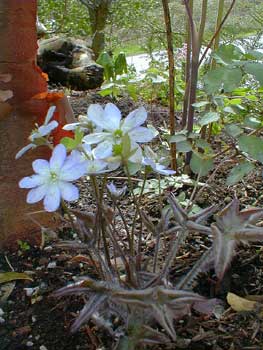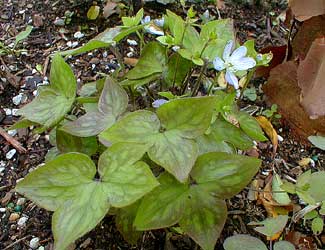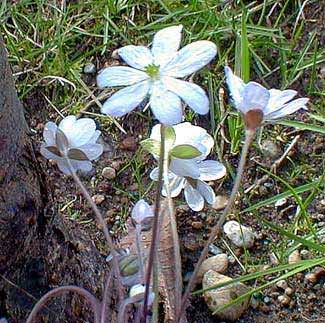
Pallid Blue
Asian Sharplobe or
Heartleaf Hepatica
"Lady! the songs of Spring were in the grove
While I was shaping beds for winter flowers."
-William Wordsworth
(1770-1850)
(1770-1850)
This little hepatica is such a light-light shade of lavender-blue that at first glance it looks white, though certainly not white enough to qualify as "Alba."
It is shown in the photograph above, snapped in late March, at the base of the paperbark maple. The available colors of blossoms of different hepaticas are usually just sold as "Mix" & only occasionally treated as named cultivars, so I unofficially named this pale-pale lavender specimen "Pallid."
In Puget Sound gardens these are in full bloom by February & this particular clump reblooms reliably throughout spring, right up to the edge of summer; other clumps stop blooming at some point, early or late, in April.
In late February & early March when it first starts flowering, it does not yet have any new leaves, but has only the beat-up liver-colored leaves remaining from the previous year's growth.
 No later than the end of March, & sometimes a bit sooner in February, I trim away the spent old leaves, & new leaves almost immediately replace them. Some clumps have leaves in evidence by the start of the second week in February, others don't show new leaves until after flower buds or even full flowers are in great evidence. So the rule of thumb would be to remove the leaves in whichever week the flower buds or tiny immature leaves are beginning to show. The old leaves should not be clipped off earlier in winter, as they are storing energy to the root throughout the cold months, while sun can reach them through the deciduous canopy.
No later than the end of March, & sometimes a bit sooner in February, I trim away the spent old leaves, & new leaves almost immediately replace them. Some clumps have leaves in evidence by the start of the second week in February, others don't show new leaves until after flower buds or even full flowers are in great evidence. So the rule of thumb would be to remove the leaves in whichever week the flower buds or tiny immature leaves are beginning to show. The old leaves should not be clipped off earlier in winter, as they are storing energy to the root throughout the cold months, while sun can reach them through the deciduous canopy.The first photograph was taken just before the brand new leaves unfolded into pointed three-lobed foliage. They look like three-pointed stars. These attractive leaves start out burgundy, but as they open into shiny pointed stars, they become a glossy green with a mottled webwork. These specifics can vary a little bit from clump to clump, so bare in mind I am describing this single specimen's general habits, & don't be surprised if you have one that has a differing habit or appearance.
The fully opened leaves with a few lingering flowers are shown in the second April photograph. When it finishes blooming, the leaves remain present the rest of the year, until they once again take on their diseased-liver coloration in winter.
 We also have a powder-blue flowered Hepatica nobilis var obtusa or American Roundlobe Hepatica, which likewise produces its new leaves after it begins to flower, but its new leaves are a shiny pure green from the start, rather than burgundy like this little "acuta" Asian Sharplobe.
We also have a powder-blue flowered Hepatica nobilis var obtusa or American Roundlobe Hepatica, which likewise produces its new leaves after it begins to flower, but its new leaves are a shiny pure green from the start, rather than burgundy like this little "acuta" Asian Sharplobe.The pointy-leafed variant "acuta" was formerly categorized as its own species H. actutiloba, while the variant with three round lobes, "obtusa," was formerly regarded as its own species, H. americana. They're now just thought of as North American & Eurasian variants of the same species. They easily hybridize for intermediate types.
In Japanese they are called Misumi, "three cornered," alluding to the leathery trilobe leaf; or they are called Yukiwari, "Snowbreaker," because it blooms in winter.
For some herbal mythology about Hepatica, see the article
The Doctrine of Signatures.
The Doctrine of Signatures.